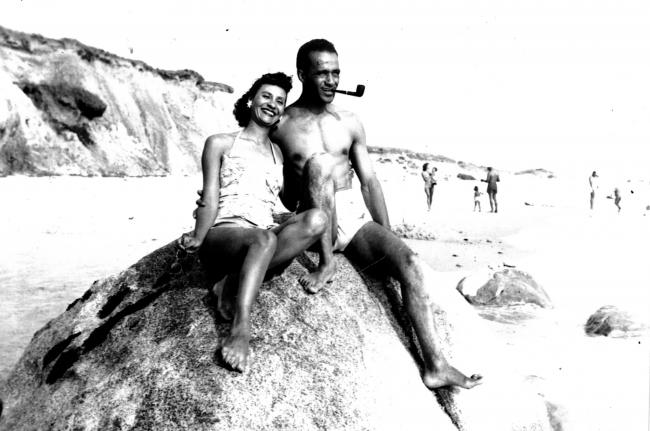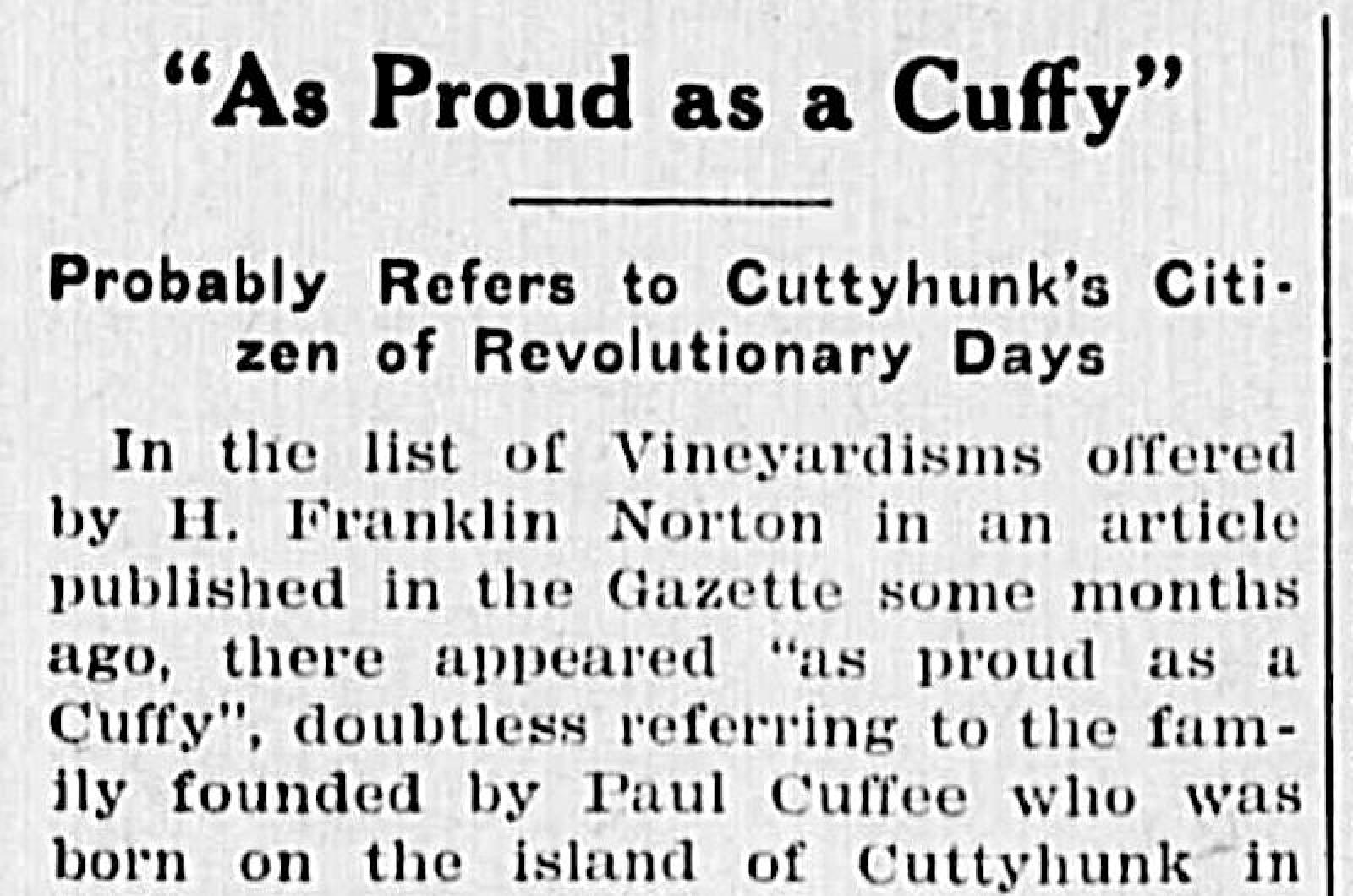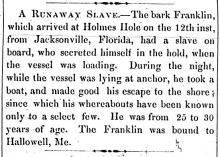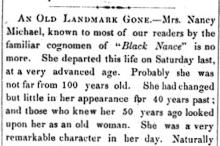In the list of Vineyardisms offered by H. Franklin Norton in an article published in the Gazette some months ago, there appeared “as proud as a Cuffy”, doubtless referring to the family founded by Paul Cuffee who was born on the island of Cuttyhunk in 1759. Captain Cuffee was something of a barbarian in his taste in wearing apparel and personal adornment. according to tradition he used to get himself up in such style that he rivalled the barber’s poles, Christmas trees and firework displays. The expression “as proud as a Cuffy” is said to have been in use more or less along the entire coast. One man bearing the name lived on the Vineyard, perhaps thirty years ago.
Paul Cuffee’s life story, as told in the Boston Globe, is of almost storybook interest, so full of romantic incident. It is here reprinted in part:
Paul Cuffee - master mariner, educator, philanthropist - was born on the island of Cuttyhunk in 1759. He was the son of a former African slave and a poor Indian woman, the youngest boy in a struggling family of ten.
...Like most health youth of the New England sea coast in his time, Paul Cuffee saw his destiny written in salt water. He went whaling. He went on a trading voyage to the West Indies. And then he was captured by the British - for the Revolution was going on - and forced to spend a three months’ imprisonment in New York...
The close of the Revolutionary War marked a big change in Cuffee’s life. His trips on the sea had finally netted him a good sum of money. He was 25; his self-education and his experience on the sea had fitted him for a master mariner’s position.
His Vessels Sailed All Over World
He moved from his island home over to the mainland and settled on the East Westport River. He married an Indian woman of the tribe his mother had belonged to. Central Village, Westport, was to be his permanent home. Here he raised his own family and hither he brought many of his brothers and sisters and their families. At his wharf several vessels were built under his supervision, and thence they sailed, with their colored crews, to all parts of the world.
In the first vessel which he himself owned he went to the St. George’s Banks for codfish, and his success proved to be an inspiration for his fellow townsmen. Immediately a fleet of codfish boats were plying between the banks and Westport. A little later he commanded a whaling expedition of his own to the coasts of Newfoundland, threw the harpoon himself and returned with his hold full of oil.
Steadily Paul Cuffee’s fortunes grew, and by 1806 he owned one ship, two brigs and many smaller vessels. He had purchased a large farm on the Westport River, where he had his wharves and warehouses....
Captain Cuffee was a leader in his community. In spite of his color, he had warm friendships and intimacies with white citizens, and these associations spread over into the fast-growing community of New Bedford near by. He was an ardent member of the Society of Friends, which predominated in Westport, and even preached frequently. One of his hobbies was education...
Finally Cuffee built at his own expense on his property a schoolhouse and threw it open to all the children both black and white.
Cuffee had many dealings with the General Court of Massachusetts over the political status of the Negroes, and the men of color in his selection looked upon him as their spokesman. He was an abolitionist, of course, and the freedom that was granted to the Massachusetts slaves around 1789 resulted, to some extent, from his influence....
Paul Cuffee’s great dream - the betterment of the Negro - probably grew slowly....He longed to help the spiritual and material condition of the free blacks in America; he saw possibilities in Africa, where the Negro problem could be attacked at its very source; he wanted American blacks to migrate back to their old home and build up there communities which would be self-sufficient and able to withstand the crushing effect of European imperialism. In his opinion, the blacks had little chance of improving themselves in places where the whites predominated.
Paul Cuffee saw in the British settlement of Sierra Leone the embodiment of his idea....He arrived in Sierra Leone in 1811....He had made the voyage at his own expense, in his brig, the Traveller, and his object was purely to observe the settlement, to find out how he could use it to further his own objects.
He gave the colonists much advice on matters spiritual and matters mercantile and he left his nephews behind him to teach the people about agriculture. He founded the Friendly Society of Sierra Leone.
Addressed Distinguished Society
The big Traveller carried Cuffee and his black crew to England, where, because of his interest in Sierra Leone, the African Institution had invited him. The Duke of Gloucester was the chairman of the board. And before this distinguished society the black captain appeared several times, to tell of his findings in Sierra Leone and to plead for support....
Once in America again, Paul Cuffee rushed with fever heat into his schemes. He had conferences with the leading Negroes of the country and with the white people who were benevolently disposed toward the blacks. He lectured and wrote on his project. He travelled hither and thither, founded in New York and Philadelphia societies to support him and spread propaganda, and looked for emigrants of the type he desired....
The War of 1812 came, and the busy planning had to stop....But in December, 1815, Cuffee’s expedition, intended to be the first of many such, left Boston, carrying thirty-eight black freemen to new homes in Sierra Leone....He himself paid personally for the passage of thirty of his passengers....On the return trip, Cuffee had reached his home waters of Buzzards Bay, he was stopped by a revenue cutter and taken into Newport, on the supposition that he was bringing in contraband goods...Leaving his Traveller at Newport he went immediately to Washington to make an appear....At the capital he went directly to president Madison, boldly told his grievance, and without the support of any counsel whatsoever he pleaded his cause. The president was impressed with the earnest bearing of the man, and an order was hurriedly sent to Newport, freeing the brig and her cargo.
The news of Cuffee’s trip to Sierra Leone spread quickly. Letters came to him from far and wide. He had more applicants for the journey eastward than he could possibly have taken care of for many trips to come. But he was delayed by difficulties in making the proper commercial arrangements, and in 1817 he died....
The cause was a lost one. Except for the little flash of enthusiasm in Paul Cuffee’s day and for the Leberia movement, the great dreams of Cuffee were in vain. The blacks themselves were never roused to any great interest, and what interest they had dwindled as time went on.
Nothing but a few rotting timbers on the beach of the East Westport River remain to show the spot where Paul Cuffee lived and worked. Houses, warehouses and ships are gone.










Comments